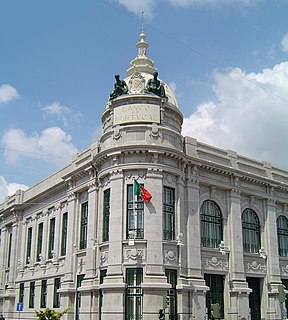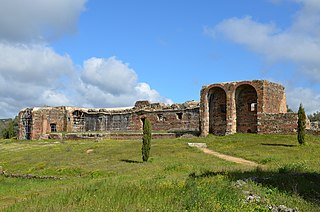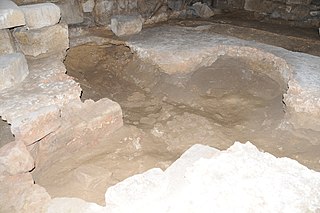
Braga is a city and a municipality in the northwestern Portuguese district of Braga, in the historical and cultural Minho Province. The city has a resident population of 192,494 inhabitants, representing the seventh largest municipality in Portugal. Its area is 183.40 km2. Its agglomerated urban area extends from the Cávado River to the Este River. It is the third-largest urban centre in Portugal.

Conímbriga is one of the largest Roman settlements excavated in Portugal, and was classified as a National Monument in 1910. Located in the civil parish of Condeixa-a-Velha e Condeixa-a-Nova, in the municipality of Condeixa-a-Nova, it is situated 2 kilometres (1.2 mi) from the municipal seat and 16 kilometres (9.9 mi) from Coimbra.

Municipium Cives Romanorum Felicitas Julia Olisipo was the ancient name of modern-day Lisbon while part of the Roman Empire.

The Church of Cedofeita is a medieval church in the civil parish of Cedofeita, municipality of Porto, in the northern Grande Porto Subregion of Portugal. The Church is a rare architectural example of a single-nave vaulted-ceiling temple, and the only one in the traditional Entre-Douro-e-Minho Province region of Portugal. It is classified as a National Monument.

The Roman ruins of São Cucufate is a Romanesque archaeological site, located on the ruins of a Roman-era agricultural farm in the civil parish of Vila de Frades, in the municipality of Vidigueira, in the southern Alentejo, Portugal. The convent, which dates back to Middle Ages, was dedicated to the martyred saint Cucuphas.

Castle of Braga is a historical fortification and defensive line encircling the city of Braga. While, in fact, the only remains of this structure are the various gates and towers along its perimeter, the main keep tower, located in the civil parish of São João do Souto, is the only true remnant of the medieval castle.

The Roman ruins of Villa Cardillio is an archaeological site located in central Portugal. Situated in the rural civil parish of Santa Maria, it is located approximately 3 km from the centre of the municipal seat of Torres Novas. Receiving its name from a mosaic pavement onsite, the specific translation of piece is still unclear, but assumed that the site was owned by a couple. The ruins were first excavated in 1962, yielding hundreds of coins and well as ceramics, bronze works, Assyrian and Egyptian glass works. Also revealed were some jewellery and a statue of Eros.

The Monastery of Dumio, is a former paleo-Christian monastery in the civil parish of Dume, municipality of Braga, in northwestern Portugal. Originally a Roman villa, it was the base of a basilica by Suebi tribes, and later Christian monastery headed by Martin of Braga in the 6th century. The re-discovery of the Roman ruins in the late 20th century resulted in archaeological excavations that unearthed its former use.

The Fountain of the Idol is a Roman fountain located in the civil parish of São José de São Lázaro, in the municipality of Braga, northern Portugal. Located in the former territory of the Callaici Bracari, the granite rock fountain/spring has Latin inscriptions, dedicated to the Gallaecian and Lusitanian gods Tongoenabiagus and Nabia.

Braga is a civil parish in the municipality of Braga, Portugal. It was formed in 2013 by the merger of the former parishes Maximinos, Sé and Cividade. The population in 2011 was 14,572, in an area of 2.57 km².

The Citânia de Briteiros is an archaeological site of the Castro culture located in the Portuguese civil parish of Briteiros São Salvador e Briteiros Santa Leocádia in the municipality of Guimarães; important for its size, "urban" form and developed architecture, it is one of the more excavated sites in northwestern Iberian Peninsula. Although primarily known as the remains of an Iron Age proto-urban hill fort, the excavations at the site have revealed evidence of sequential settlement, extending from the Bronze to Middle Ages.

The Bridge of Prozelo is a bridge in the civil parish of Ferreiros, Prozelo e Besteiros, municipality of Amares, in the Portuguese district of Braga, that crosses the Cávado River.

The Bridge of Prado is a bridge constructed over the Cávado River, in the civil parish of Vila de Prado, municipality of Vila Verde, in Norte Region, Portugal northern Portugal. Although originally a Roman bridge, it was re-constructed during the 16th century when the original had been destroyed following flooding and consistent use. There are few vestiges of the Roman bridge.

The Roman Ruins of Cerro da Vila are the remnants of a historical villa in the Algarve region of southern Portugal. Its vestiges lie in the vicinity of the resort and marina of Vilamoura, in the civil parish of Quarteira, municipality of Loulé Municipality.

The Castle of Faria is a castle in the northern Portuguese civil parish of Gilmonde, municipality of Barcelos, in the Cávado.

The Roman ruins of Casais Velhos are the remains of a Roman town, in the municipality of Cascais, Lisbon District, Portugal that included baths, two cemeteries, remains of a wall and ceramic artifacts.

The Roman villa of Alto da Cidreira is a Roman villa in the civil parish of Alcabideche, municipality of Cascais, in the Lisbon District of Portugal. Although known since the 1890s, this site has largely been neglected by archaeologists, resulting in destruction of artefacts, including Roman era mosaics, a bath complex and an olive oil cellar.
The Roman villa of Outeiro de Polima is a Roman villa in the civil parish of São Domingos de Rana, in the Portuguese municipality of Cascais, dating from the 1st to 6th centuries AD.

The Roman Milestones of Braga are a series of ancient road markers located in civil parish of Braga, municipality of Braga in northern Portugal.

The Roman Ruins of Milreu are the remains of an important Roman villa rustica located in the civil parish of Estói in the municipality of Faro, Portugal, classified as a Monumento Nacional. The Milreu ruins constitute the most prominent and well preserved evidence of Roman presence in the Algarve, and are mainly composed of the remnants of a once luxurious villa with annexed thermae and several surrounding buildings, including a temple, mausoleum and industrial and commercial structures. The archaeological site still preserves part of the once exuberant mosaics that decorated the floor and walls of the villa. A 16th century house is also located in the area, alongside an interpretation centre.



















